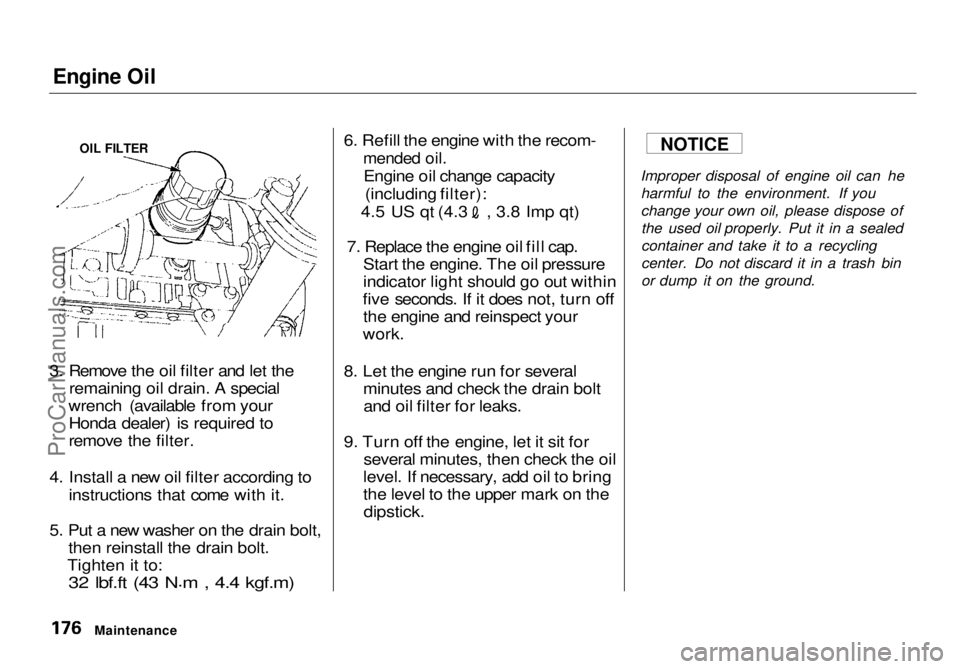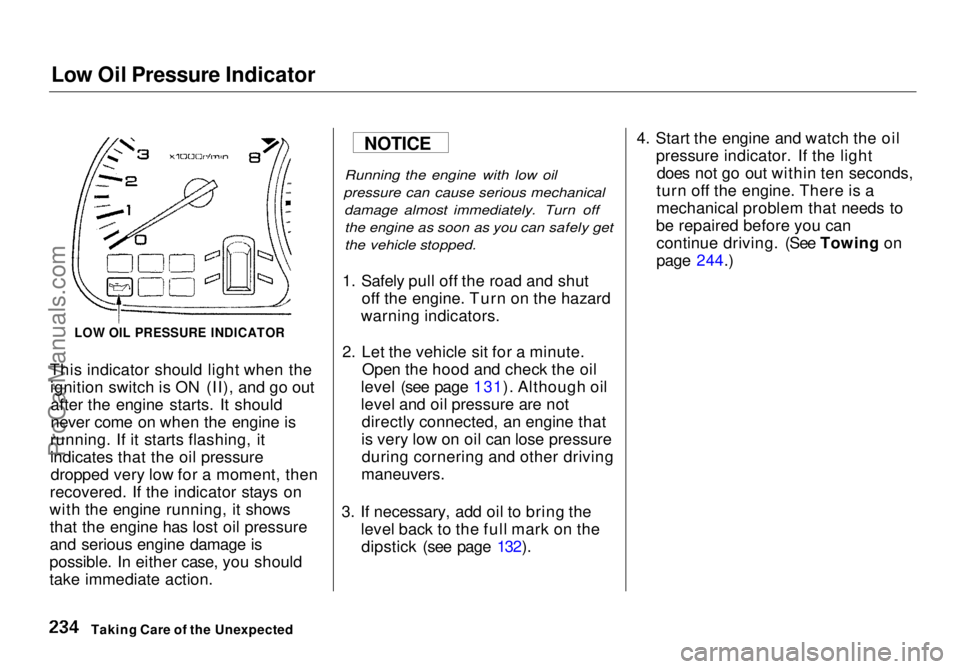Page 131 of 272
Service Station Procedures
Check the engine oil level every time you fill the vehicle with fuel. Wait a
few minutes after turning the engineoff before you check the oil.
1. Remove the dipstick (orange
handle).
2. Wipe the dipstick with a clean
cloth or paper towel. 3. Insert it all the way back in its tube.
CONTINUED
Before Driving
Oil Check
DIPSTICKProCarManuals.comMain Menu Table of Contents s t
Page 132 of 272
Service Station Procedures
4. Remove the dipstick again and check the level. It should be
between the upper and lower
marks.
If it is near or below the lower mark,
see Adding Oil on page 173. Look at the coolant level in the
radiator reserve tank. Make sure it is
between the MAX and MIN lines. If
it is below the MIN line, see Adding
Engine Coolant on page 177 for
information on adding the proper
coolant. Refer to Owner Maintenance
Checks on page 171 for information
on checking other items in your
Honda.
Before Driving
UPPER MARK
LOWER MARK Engine Coolant Check
MAX MIN
RESERVE TANKProCarManuals.comMain Menu Table of Contents s t
Page 171 of 272
Fluid Locations
Maintenance
BRAKE FLUID
(Gray cap)
ENGINE OIL
FILL CAP
COOLANT
RESERVOIR
POWER STEERING
FLUID (Red cap)
AUTOMATIC
TRANSMISSION
FLUID DIPSTICK
(Yellow loop)
WASHER FLUID
(Blue cap)
ENGINE OIL DIPSTICK
(Orange loop)ProCarManuals.comMain Menu Table of Contents s t
Page 175 of 272

Engine Oil
3. Remove the oil filter and let the remaining oil drain. A special
wrench (available from your Honda dealer) is required to
remove the filter.
4. Install a new oil filter according to instructions that come with it.
5. Put a new washer on the drain bolt, then reinstall the drain bolt.
Tighten it to:32 lbf.ft (43 N .
m , 4.4 kgf.m)
6. Refill
the engine with the recom-
mended oil.
Engine oil change capacity (including filter): 4.5 US qt (4.3 , 3.8 Imp qt)
7. Replace the engine oil fill cap. Start the engine. The oil pressure
indicator light should go out within
five seconds. If it does not, turn off the engine and reinspect your
work.
8. Let the engine run for several minutes and check the drain boltand oil filter for leaks.
9. Turn off the engine, let it sit for several minutes, then check the oil
level. If necessary, add oil to bring
the level to the upper mark on the
dipstick.
Improper disposal of engine oil can he
harmful to the environment. If you
change your own oil, please dispose ofthe used oil properly. Put it in a sealed
container and take it to a recycling
center. Do not discard it in a trash bin
or dump it on the ground.
Maintenance
OIL FILTER
NOTICEProCarManuals.comMain Menu Table of Contents s t
Page 231 of 272

Low Oil Pressure Indicator
This indicator should light when the ignition switch is ON (II), and go outafter the engine starts. It should
never come on when the engine is
running. If it starts flashing, it
indicates that the oil pressure dropped very low for a moment, then
recovered. If the indicator stays on
with the engine running, it shows that the engine has lost oil pressure
and serious engine damage is
possible. In either case, you should
take immediate action.
Running the engine with low oil
pressure can cause serious mechanical damage almost immediately. Turn offthe engine as soon as you can safely get
the vehicle stopped.
1. Safely pull off the road and shut off the engine. Turn on the hazard
warning indicators.
2. Let the vehicle sit for a minute. Open the hood and check the oil
level (see page 131). Although oil
level and oil pressure are not directly connected, an engine that
is very low on oil can lose pressure during cornering and other driving
maneuvers.
3. If necessary, add oil to bring the level back to the full mark on thedipstick (see page 132). 4. Start the engine and watch the oil
pressure indicator. If the lightdoes not go out within ten seconds,
turn off the engine. There is a
mechanical problem that needs to
be repaired before you can continue driving. (See Towing on
page 244.)
Taking Care of the Unexpected
LOW OIL PRESSURE INDICATOR
NOTICEProCarManuals.comMain Menu Table of Contents s t
Page 265 of 272

Index
Coolant
Adding......................................... 177
Checking..................................... 132
Proper Solution.......................... 177
Temperature Gauge.................... 55
Corrosion Protection..................... 218
Crankcase Emission Control
System......................................... 255
Cruise Control Operation............... 64
Customer Relations Office........... 251
DANGER, Explanation of................. ii
Dashboard........................................ 50 Dashboard Compartment............... 88
Daytime Running Lights................. 58
Dead Battery, What to Do............ 230 Defects, Reporting Safety............. 264
Defogger, Rear Window................. 61
Defrosting the Windows................. 99
DEXRON ®
III Automatic
Transmission Fluid.................... 182
Dimensions..................................... 248
Dimming the Headlights................ 58 Dipstick
Automatic Transmission........... 182
Engine Oil................................... 131
Directional Signals........................... 59
Disabled, Towing Your Car If...... 244
Disc Brake Wear Indicators......... 147
Disposal of Used Oil...................... 176
Doors Locking and Unlocking............... 70
Power Door Locks....................... 70
DOT Tire Quality Grading........... 251
Driver and Passenger Safety............ 3
Drive Belts...................................... 195
Driving............................................ 139 Economy..................................... 133
In Bad Weather.......................... 148
In Foreign Countries................. 254
Economy, Fuel............................... 133
Emergencies on the Road............. 221
Battery, Jump Starting.............. 230
Brake System Indicator............ 237
Changing a Flat Tire................. 223
Chargilng System Indicator ...... 235 Checking the Fuses................... 240
Low Oil Pressure Indicator...... 234
Malfunction Indicator Lamp.... 236
Manually Closing Sunroof........ 238
Overheated Engine................... 232
Emergency Brake............................ 85
Emergency Flashers....................... 61
Emission Controls......................... 255
Engine Belts............................................. 195
Coolant Temperature Gauge ..... 56
Malfunction IndicatorLamp................................. 32, 236
Oil Pressure Indicator......... 32, 234
Oil, What Kind to Use............... 173 Overheating................................ 232
Specifications............................. 249
Ethanolin Gasoline....................... 254 Evaporative Emission Controls.... 255
Exhaust Fumes................................ 47
Expectant Mothers, Use of Seat Belts by......................................... 17
Exterior, Cleaning the................... 214
CONTINUEDProCarManuals.comMain Menu s t